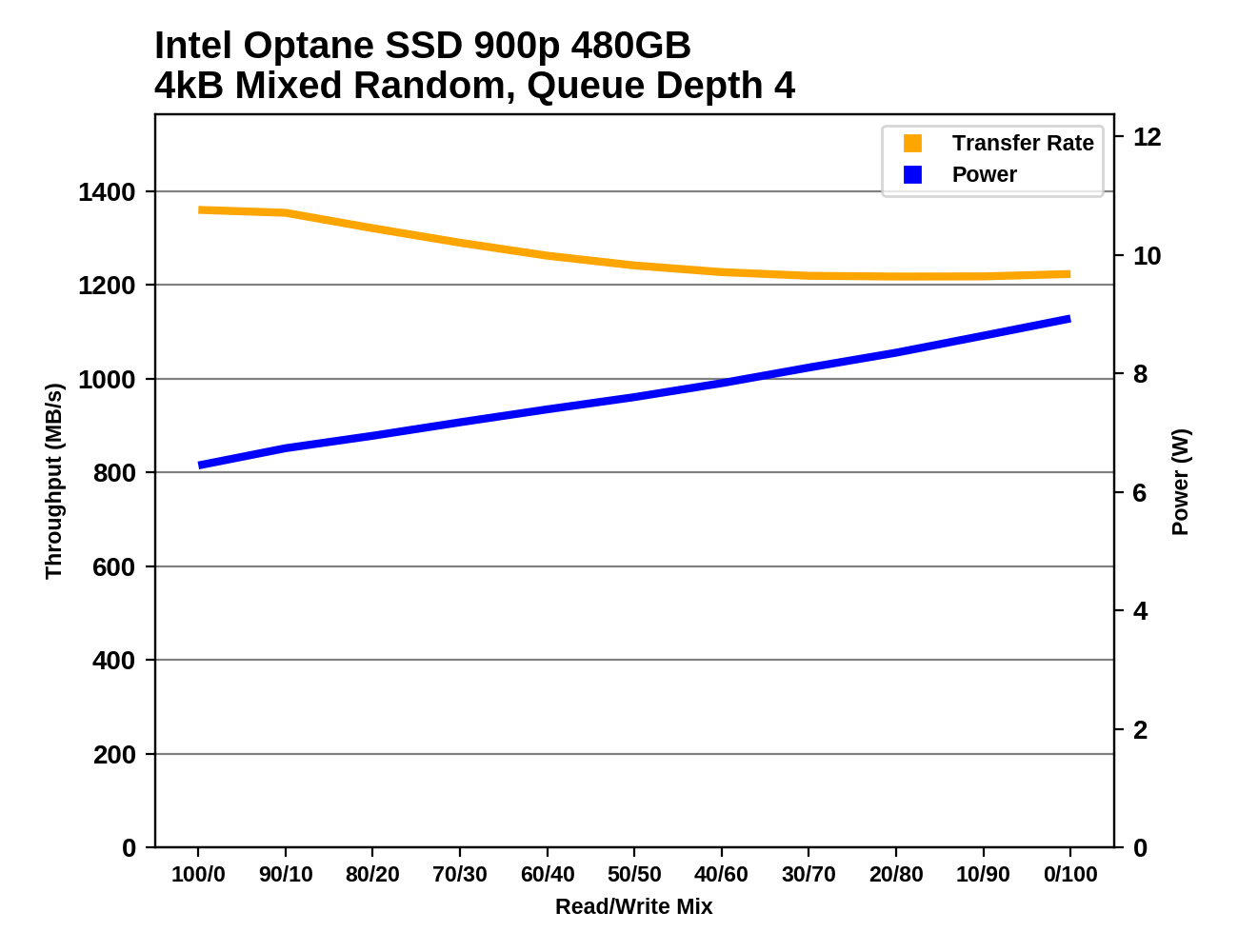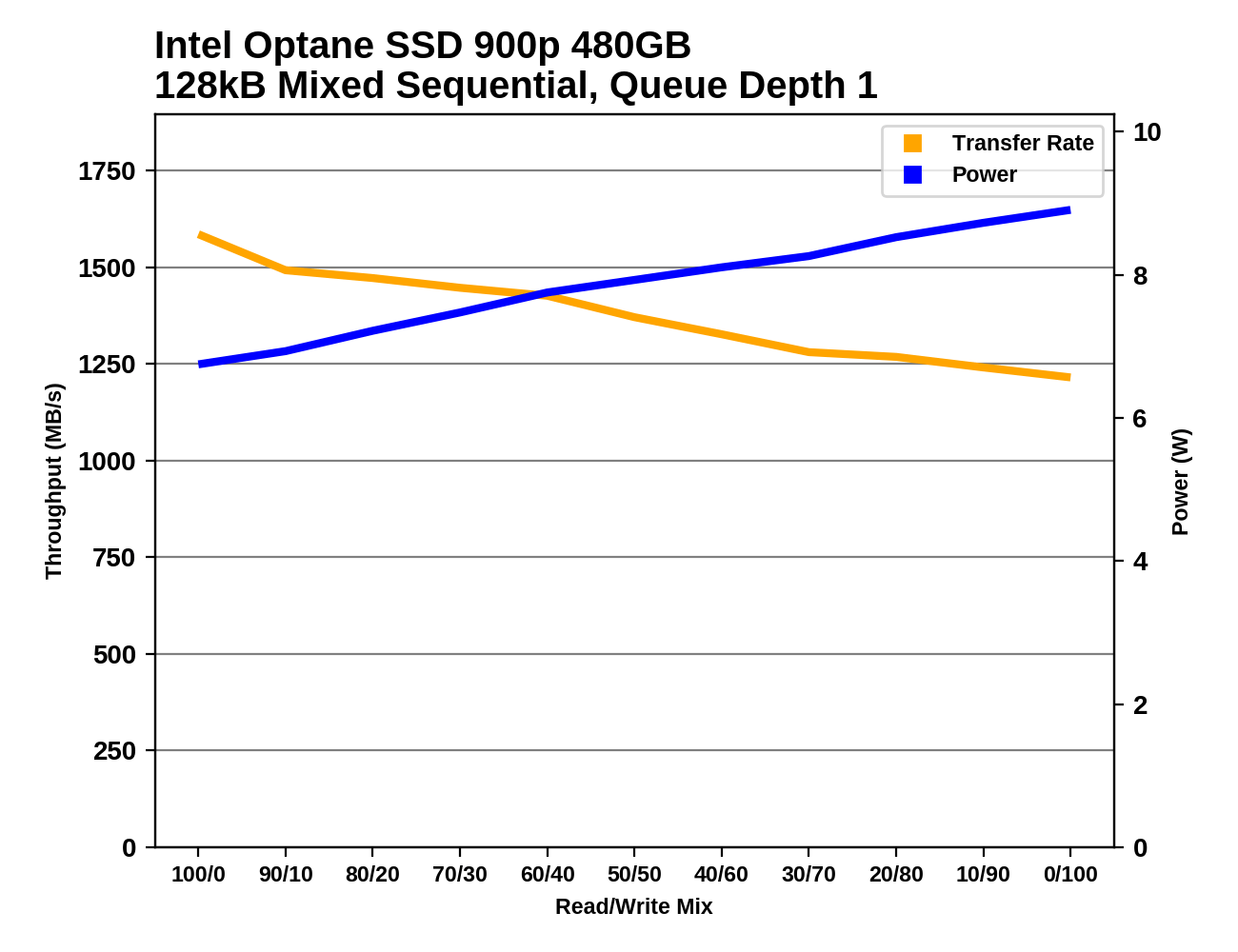The Intel Optane SSD 900p 480GB Review: Diving Deeper Into 3D XPoint
by Billy Tallis on December 15, 2017 12:15 PM ESTMixed Random Performance
Our test of mixed random reads and writes covers mixes varying from pure reads to pure writes at 10% increments. Each mix is tested for up to 1 minute or 32GB of data transferred. The test is conducted with a queue depth of 4, and is limited to a 64GB span of the drive. In between each mix, the drive is given idle time of up to one minute so that the overall duty cycle is 50%.

Since this mixed random I/O test is conducted at the relatively low queue depth of four, the Optane SSDs have a large performance advantage, and even the tiny Optane Memory M.2 does well (though it has to run a slightly modified version of the test due to its low capacity). The Optane SSDs are more than three times faster overall than the highest-scoring flash-based SSD.

The Optane SSDs have a substantial power efficiency lead on the mixed random I/O test, but it is small enough that flash-based SSDs could conceivably catch up with a generation or two of improvements. As usual, the 480GB model has clearly lower efficiency because its minor performance advantage doesn't outweigh the power cost the extra 3D XPoint memory chips.
 |
|||||||||
Both capacities of the Intel Optane SSD 900p show a modest decline in performance as the workload becomes more write-heavy, and a fairly linear increase in power consumption. The 480GB model's power consumption grows slightly faster than the 280GB model, leading to a 0.9W gap at the end of the test.
Even the Intel SSD 750 draws substantially less power for most of the test, though it catches up at the very end. The flash-based M.2 NVMe SSDs are mostly drawing a fraction of what the Optane SSDs require. In terms of performance, none of the flash-based SSDs come at all close to the Optane SSDs until the very end of the test, where many are able to deliver good random write speed.
Mixed Sequential Performance
Our test of mixed sequential reads and writes differs from the mixed random I/O test by performing 128kB sequential accesses rather than 4kB accesses at random locations, and the sequential test is conducted at queue depth 1. The range of mixes tested is the same, and the timing and limits on data transfers are also the same as above.

The Intel Optane SSD 900p is much faster on the mixed sequential I/O test than any consumer flash-based SSD. Samsung's best drives are slower by a third, and it's downhill from there for NAND flash. The 480GB model actually performed slightly worse on this test than the 280GB model, but the difference is small enough it may simply be due to variation between runs.

The power efficiency of the Optane SSD 900p on the mixed sequential I/O test is good but not quite at the top of the charts. Instead, it is on par with the Samsung 960 EVO, which sacrificed a bit of efficiency to improve performance relative to the Samsung 950 PRO.
 |
|||||||||
The 280GB Optane SSD 900p was a bit faster than the 480GB overall but a bit less steady over the course of the test. The scaling of the Optane SSDs is quite similar to the results from the mixed random test: a gradual decline in performance as the proportion of writes increases, and a linear increase in power consumption. The overall performance level is significantly higher than for the random I/O test.
The flash-based SSDs can get much closer to competing with the Optane SSDs on this mixed sequential test than on the mixed random test. Several drives have sequential read speeds that approach that of the Optane SSDs, and a few have higher sequential write performance. But through the middle portions of the test, the flash-based SSDs all lose a lot of their performance for at least a few phases of the test, while the Optane SSD has no acute performance weakness.










69 Comments
View All Comments
nathanddrews - Friday, December 15, 2017 - link
Is there any indication that performance would degrade with a lesser CPU or improve with a faster CPU? Just curious if we should expect CPU bottlenecks from these hyper-speed SSDs.Billy Tallis - Friday, December 15, 2017 - link
Yes, CPU speed can definitely affect latency and consistency and maximum achievable IOPS. Some of those limits were hit with the P4800X testing on a server with lower per-core performance than this consumer testbed.At the moment, my inclination is to leave the consumer test suite single-threaded, because consumer workloads don't actually hit the queue depths necessary to go beyond the I/O capabilities of a single CPU core. I don't care too much if the high QD range on some of the graphs doesn't quite reach the theoretical limit of the drive, because that's not the part of the graph we should be paying attention to. (For consumer drives.)
At low queue depths, interrupt servicing latency can be helped a bit by a faster CPU. But for most consumers, switching from Windows to Linux will do a lot more to help reduce their storage latency. And saving a few more microseconds only matters on Optane; mainstream products won't be this fast for quite a while.
ddrіver - Friday, December 15, 2017 - link
I think I'll have to reevaluate my position on Optane. Seems like a solid product. Guess I misread the signs.ddriver - Friday, December 15, 2017 - link
How can you tell a fake "ddriver" apart? Well, the real one would never mislabel the product hypetane ;)It is what it is, and still nowhere nearly "1000x" better as intel claimed. It has its niche strengths, but those offer no tangible benefit to 99.9999% of the consumers out there. I don't recall ever claiming that it will suck, my claim has always been that it will epically fail to live up to the hype, which testing thoroughly confirms. It is not even 10% of "1000x better". So hypetane it is.
SLC flash can easily match and even bet it in most performance metrics. Unfortunately the industry is not even trying, even mlc is now considered "ultra high end enterprise". Which is understandable, as the workloads that could actually benefit from higher performance are very few and far in between, and for 99% of them using ram is the more applicable and still tremendously better performing solution.
It is definitely not a bad product on its own. And I would not refer to it as "hypetane" if only intel hadn't shamelessly lied about it on such a preposterous scale.
tuxRoller - Friday, December 15, 2017 - link
Interface speeds≠ media speedsWhen will you learn?
Also, still need a reference for those SLC numbers.
LordanSS - Saturday, December 16, 2017 - link
Indeed, Interface speeds are not "media" speeds. I never expected it to work according to Intel's "1000x" claims, but was hoping for a more in-line 20x better from what we currently have, considering first generation product and all.And it doesn't even do that. Sorry, for this one time, I am (partially) siding with ddriver.
lmcd - Saturday, December 16, 2017 - link
20X better overall is entirely unrealistic. Certain attributes are 20X better. That is all you can really expect when so many things (form factor, power usage, interface protocols, physical interface, etc) are retained from the previous generation.LordanSS - Sunday, December 17, 2017 - link
20x is 2% (TWO PERCENT) of what Intel claimed when they disclosed XPoint. It's not realistic?Intel shoul have kept their mouth shut back then, just like Micron has done so until now. If they can't even do 2% of what they claimed, they're the unrealistic ones.
tuxRoller - Sunday, December 17, 2017 - link
Were those claims that Intel made in reference to xpoint the tech, or optane the first gen product?tuxRoller - Saturday, December 16, 2017 - link
I'm not sure why you are quoting media, but you are absolutely welcome to be disappointed.You'll notice I don't care whether anyone thinks Intel over hyped their product only that we still don't know what the actual xpoint (the media, or "tread + xfer + Misc" times, as Handy refers to it) response times look like.
If AT doesn't allow the below link, search for "xpoint presence in slow lane explained" on the register, or Google "Why XPoint SSDs won't meet original speed claims: A guide"
https://www.theregister.co.uk/2016/09/29/xpoint_pr...